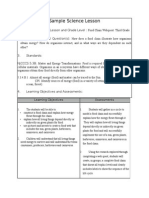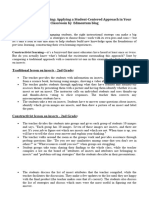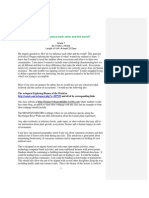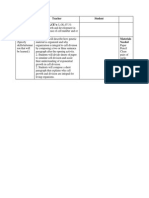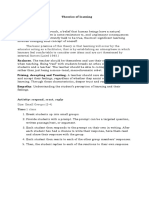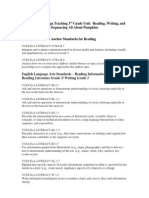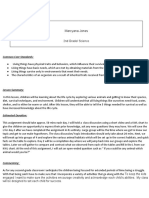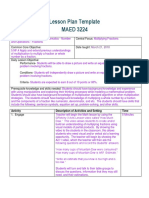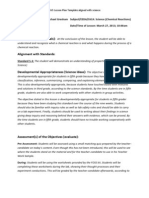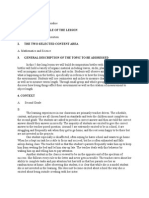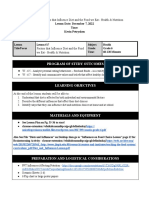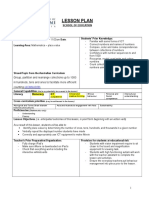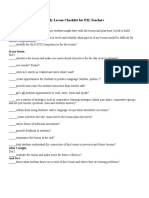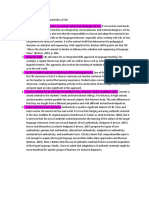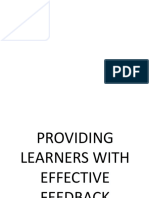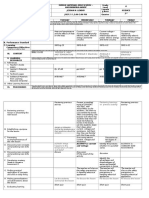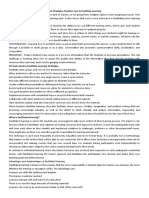Formative Assessments
Formative Assessments
Uploaded by
api-206425379Copyright:
Available Formats
Formative Assessments
Formative Assessments
Uploaded by
api-206425379Original Title
Copyright
Available Formats
Share this document
Did you find this document useful?
Is this content inappropriate?
Copyright:
Available Formats
Formative Assessments
Formative Assessments
Uploaded by
api-206425379Copyright:
Available Formats
Formative Assessments Wait Time 1. List the benchmark (written out) SC.7.L.17.
3 Describe and investigate various limiting factors in the local ecosystem and their impact on native populations, including food, shelter, water, space, disease, parasitism, predation, and nesting sites. 2. Describe the assessment task exactly as the students will see it, including any questions or prompts that you will use. The teacher will ask questions to the students and wait at least five seconds for them to answer. Example: What are some things that living things require to survive? I will give you five seconds to think about this before you answer. 3. In your own words, describe your rationale for using this form of assessment, including: 1. How it promotes student learning Well when asked a question most students will answer with the first thought that enters their mind. However this first thought isnt exactly always the right thought. If the students were given a little more time to answer the question they could probably come up with a correct answer. Also, sometimes the question seems too difficult to answer and some students will not be given a chance to think deeply about the question. Given more time will get the students to try to figure the complex question instead of just waiting to be given the answer by the teacher or some other student. 2. How it informs instruction This informs instructions because the teacher can get a better sense of what students dont understand and what they truly understand. If the students are given more time to answer a question. The teacher can expect a better answer or at least the best answer a students can give. This should be a great measurement of the true rational and understanding a student has of the topic.
Thought Experiments 1. List the benchmark (written out) SC.7.L.17.3 Describe and investigate various limiting factors in the local ecosystem and their impact on native populations, including food, shelter, water, space, disease, parasitism, predation, and nesting sites.
2. Describe the assessment task exactly as the students will see it, including any questions or prompts that you will use. The teacher will ask a question that will ask a question or questions that will ignite the students thoughts with a question that is completely hypothetical and cannot be actually measured in the classroom. Example: What would occur if all the plants in the world were extinct? I will give you five minutes to think about this and then discuss this with your groups. After five minutes the class will have a class discussion to explore all of the students ideas and deep thoughts. They will be able to build off of each other hopefully and create an atmosphere of learning and acceptance. 3. In your own words, describe your rationale for using this form of assessment, including: 1. How it promotes student learning This exercise will promote the students to think about something that they cannot see but require deep thinking to come up with an answer. It will allow the student to feel comfortable sharing their deep thoughts and possibly transfer the conceptual understanding gained from the exercise to a new context. It will also generate interest in the student and get them to want to learn more about the related concept. 2. How it informs instruction It informs the instruction because as the student share their ideas the teacher is able to gain an insight of the students deep thought and their understanding.
Whiteboarding 1. List the benchmark (written out) SC.7.L.17.1 Explain and illustrate the roles of and relationships among producers, consumers, and decomposers in the process of energy transfer in a food web. 2. Describe the assessment task exactly as the students will see it, including any questions or prompts that you will use. Teacher will hand out whiteboards and markers to each student. We are going to create our own food webs. Work with your group to decide what animals to include but you have to create your own food web on a whiteboard. What type of organisms should you include? [Decomposers, producers, consumers, sun] [sun, plants, herbivores, omnivores/carnivores] Make sure they are in the correct order. You have three minutes to complete your food web. Walk around the class observing students and helping them. After three minutes, have students share their food webs, asking questions such as What is your primary consumer? or what is your top predator? or which animal has the most energy or which organism would have the largest population?
3. In your own words, describe your rationale for using this form of assessment, including: 1. How it promotes student learning This formative assessment promotes student learning by helping the teacher learn about students prior knowledge and current ideas about the topic. Also when used at the beginning at the class allows students to start thinking. It also gives students the opportunity to interact with classmates and share their ideas. The whiteboards also allows students to easily modify their work. 2. How it informs instruction Instruction can gain from this exercise because It allows teacher to immediately address students misconception and because it is class activity all the students are able to learn from the correction of misconceptions.
Think-pair-share Immediately after Whiteboarding, I would use this activity to allow students to work further with their whiteboard work. 1. SC.7.L.17.1 Explain and illustrate the roles of and relationships among producers, consumers, and decomposers in the process of energy transfer in a food web. 2. Now I will have you predict what will happen when one population changes. Pick a student to choose which level of the food chain will experience the change. Pick another student to choose how the population will change. First we will take thirty seconds to think about how the food web will be affected. If you need to you can write down what your ideas, but no talking for thirty seconds. Teacher will start the timer and ask probing questions throughout. Does changing the population of an organism only affect the ones above it? Does it cause a change in organisms that are not directly above or below it on the food chain? How about the environment? Could this change affect the environment? If so, how could that affect the remaining animals over time? After thirty seconds inform students that they will now have one minute to talk with a partner about what they think will happen in their ecosystem. You will now move into pairs and talk about what you decided will happen when a population increases. After a minute initiate a class discussion where the students all share their ideas. 3. How it promotes student learning This activity is similar to Whiteboarding in that it lets students think about the topic before engaging in class discussion. Students are able to work with their partner to share ideas and can modify their prediction as they see fit. When they are then engaged in class discussion they will have more to offer and have better prepared answers and comments.
How it informs instruction Think-pair-share informs instruction by allowing teacher to address inaccuracies and give immediate feedback to students.
You might also like
- Sample Lesson Plans and RationaleDocument40 pagesSample Lesson Plans and Rationaleapi-25376269356% (9)
- Bda Lesson PlanDocument6 pagesBda Lesson Planapi-403388857No ratings yet
- Lesson Plan PhotosynthesisDocument5 pagesLesson Plan Photosynthesissmily_face15No ratings yet
- Dyi Dichotomous Key Guided Inquiry PaperworkDocument7 pagesDyi Dichotomous Key Guided Inquiry Paperworkapi-250608665No ratings yet
- NB Guidelines and Standards-Educational Planning For Students With ExceptionalitiesDocument34 pagesNB Guidelines and Standards-Educational Planning For Students With Exceptionalitiesapi-249986210No ratings yet
- Term 4 Lessonplan 1Document3 pagesTerm 4 Lessonplan 1api-309968556No ratings yet
- Edsc 442c Argumentation Lesson PlanDocument7 pagesEdsc 442c Argumentation Lesson Planapi-310901771No ratings yet
- Differentiation Lesson PlanDocument6 pagesDifferentiation Lesson Planapi-479190878No ratings yet
- Grade 5 Lesson PlanDocument5 pagesGrade 5 Lesson PlanLisa WeberNo ratings yet
- Science Notes (Midterm)Document8 pagesScience Notes (Midterm)Carmela IsabellaNo ratings yet
- Inquiry 5e Lesson Plan TemplateDocument3 pagesInquiry 5e Lesson Plan Templateapi-488045418No ratings yet
- Life ScienceDocument12 pagesLife Scienceapi-341588663No ratings yet
- Inquiry Unit Full PDFDocument35 pagesInquiry Unit Full PDFapi-234877943No ratings yet
- EDUC 2220-Educational Technology Lesson Plan: Common Core StandardsDocument4 pagesEDUC 2220-Educational Technology Lesson Plan: Common Core StandardsDamiNo ratings yet
- A Frogs Skin - Lesson PlanDocument5 pagesA Frogs Skin - Lesson Planapi-255425919No ratings yet
- Jacob Burkart 5 e Lesson Plan With Assessments Formative and SummativeDocument11 pagesJacob Burkart 5 e Lesson Plan With Assessments Formative and Summativeapi-726787234No ratings yet
- Lesson PlanDocument4 pagesLesson PlanDamiNo ratings yet
- Lesson Plan Plant CareDocument3 pagesLesson Plan Plant Careapi-300472292100% (1)
- Peer Bothwell LessonDocument4 pagesPeer Bothwell Lessonapi-266319948No ratings yet
- Stem 5e Food Web Lesson PlanDocument5 pagesStem 5e Food Web Lesson Planapi-282818759No ratings yet
- 442lpinvestigationnew 1Document7 pages442lpinvestigationnew 1api-269205264No ratings yet
- Updated Plant UnitDocument16 pagesUpdated Plant Unitapi-334923179No ratings yet
- Educ 335 - Reactions FinalDocument4 pagesEduc 335 - Reactions Finalapi-550981792No ratings yet
- Lesson Plan Template: Learning Goal: UnderstandDocument5 pagesLesson Plan Template: Learning Goal: Understandapi-317479882100% (1)
- Observation Sheet - Pinjarra High SchoolDocument8 pagesObservation Sheet - Pinjarra High Schoolapi-263206210No ratings yet
- Sophie Lee Cps Lesson PlanDocument16 pagesSophie Lee Cps Lesson Planapi-233210734No ratings yet
- Revisions Pepin and Hill Te804 Lessonplan1 VarricchioneDocument5 pagesRevisions Pepin and Hill Te804 Lessonplan1 Varricchioneapi-252759873No ratings yet
- Scientific Inquiry Lesson For Second GradeDocument6 pagesScientific Inquiry Lesson For Second GradeGabrielle DeSano0% (1)
- Blended Learning Lesson Plan: Detailed Paragraphs From Here On DownDocument3 pagesBlended Learning Lesson Plan: Detailed Paragraphs From Here On Downapi-510178377No ratings yet
- Single Subject Credential Program EDSC Lesson Plan Template: Precious Daileg, Estefani Bautista, Brit Brown BiologyDocument7 pagesSingle Subject Credential Program EDSC Lesson Plan Template: Precious Daileg, Estefani Bautista, Brit Brown Biologyapi-257666656No ratings yet
- A-VED 311-Requirements For Midterm - Mrs. Condeza PDFDocument15 pagesA-VED 311-Requirements For Midterm - Mrs. Condeza PDFgenelyn gunoNo ratings yet
- Instructional Partner Unit FinalDocument7 pagesInstructional Partner Unit Finalapi-241431131No ratings yet
- Pbi Calendar 2Document9 pagesPbi Calendar 2api-206424278No ratings yet
- Marcyana Jones: Common Core StandardsDocument4 pagesMarcyana Jones: Common Core StandardsMarcyana JonesNo ratings yet
- Kelsie Wall - MAED 3224 Lesson Plan TemplateDocument9 pagesKelsie Wall - MAED 3224 Lesson Plan TemplateKelsie M WallNo ratings yet
- Lesson Plan DesignDocument6 pagesLesson Plan Designapi-439800340No ratings yet
- Active Learning: An Introduction Richard M. Felder Rebecca BrentDocument7 pagesActive Learning: An Introduction Richard M. Felder Rebecca BrentGedionNo ratings yet
- GSW Lesson Plan Spring HarleyDocument9 pagesGSW Lesson Plan Spring Harleyapi-287199905No ratings yet
- Edtpa Lesson PlanDocument5 pagesEdtpa Lesson Planapi-253424232No ratings yet
- Plant Needs Lesson 1Document2 pagesPlant Needs Lesson 1api-242598917No ratings yet
- 1e F - Natural Resource Presentation Lesson PlanDocument7 pages1e F - Natural Resource Presentation Lesson Planapi-279609143No ratings yet
- Formal Science LessonDocument9 pagesFormal Science Lessonapi-333935012No ratings yet
- Evaluation of Learning 2Document5 pagesEvaluation of Learning 2api-252334861No ratings yet
- Analysis of Classroom Interactions, Student Learning, & ReflectionDocument4 pagesAnalysis of Classroom Interactions, Student Learning, & Reflectionapi-331725052No ratings yet
- Lessonplan 12 4 14Document8 pagesLessonplan 12 4 14api-273472842No ratings yet
- Immersion Science Plan 2Document11 pagesImmersion Science Plan 2api-213553729No ratings yet
- Seed StoryDocument4 pagesSeed Storyapi-219914719No ratings yet
- Lesson Plan On Multiplying FractionsDocument6 pagesLesson Plan On Multiplying Fractionsapi-282209377No ratings yet
- Examples - Education - Part 4 - by DylanDocument4 pagesExamples - Education - Part 4 - by DylanĐào Nhật HiểnNo ratings yet
- 04 Beyond The Basic Prductivity Tools Lesson Idea Template 1Document2 pages04 Beyond The Basic Prductivity Tools Lesson Idea Template 1api-477468467No ratings yet
- Examine, Evaluate, Question, and Ethically Use Information From A Variety of Sources and Media To Investigate Ecosystem InteractionsDocument6 pagesExamine, Evaluate, Question, and Ethically Use Information From A Variety of Sources and Media To Investigate Ecosystem Interactionsapi-356824125No ratings yet
- Very Hungry Caterpillar LessonDocument5 pagesVery Hungry Caterpillar Lessonnajlac103No ratings yet
- EDU 387 Lesson Plan: Template With Guiding QuestionsDocument4 pagesEDU 387 Lesson Plan: Template With Guiding Questionsapi-247664759No ratings yet
- Indiana Wesleyan University Emily Gerycz Science Lesson One Lesson RationaleDocument4 pagesIndiana Wesleyan University Emily Gerycz Science Lesson One Lesson Rationaleapi-351459176No ratings yet
- Edt 473 - Lesson StudyDocument6 pagesEdt 473 - Lesson Studyapi-285766954No ratings yet
- Edu 542 - Web NotesDocument13 pagesEdu 542 - Web Notesapi-251922415No ratings yet
- Lesson #17 - Factors That Influence Diet and The Food We Eat - Health & NutritionDocument5 pagesLesson #17 - Factors That Influence Diet and The Food We Eat - Health & NutritionKevin PetryshenNo ratings yet
- Locasey-Assignment-1 Lesson-Plan-FinalDocument4 pagesLocasey-Assignment-1 Lesson-Plan-Finalapi-661751964No ratings yet
- Plant Cell Lesson Plan Page 1Document10 pagesPlant Cell Lesson Plan Page 1api-354930391No ratings yet
- Bloom Educational ImplicationDocument4 pagesBloom Educational ImplicationBernard MartinNo ratings yet
- Innovative Lesson PlanDocument7 pagesInnovative Lesson PlanShannon GordonNo ratings yet
- Profed 107: Learning in Assessment Diagnostic AssessmentDocument5 pagesProfed 107: Learning in Assessment Diagnostic AssessmentPeralta Myra FeNo ratings yet
- Student Perception Survey Questions 1819Document4 pagesStudent Perception Survey Questions 1819api-306720213No ratings yet
- ICT Lesson 4Document3 pagesICT Lesson 4Annalise BrownNo ratings yet
- Aptitude Tests and The Legal Profession Final ReportDocument111 pagesAptitude Tests and The Legal Profession Final ReportelavioNo ratings yet
- Shri Bhumika High School Parye Sattari-GoaDocument2 pagesShri Bhumika High School Parye Sattari-GoaShital KotkarNo ratings yet
- Angelyn Natividad - TEMPLATE FOR MULTI-MODAL ASSESSMENT STRATEGIESDocument9 pagesAngelyn Natividad - TEMPLATE FOR MULTI-MODAL ASSESSMENT STRATEGIESAngelyn Taberna NatividadNo ratings yet
- Developmental Learning Activities (Indirect Approach) : Daren Sauza-NgadimaDocument17 pagesDevelopmental Learning Activities (Indirect Approach) : Daren Sauza-Ngadimadanaya fabregasNo ratings yet
- Ilt Data Analysis Worksheet-2016-PrimaryDocument3 pagesIlt Data Analysis Worksheet-2016-Primaryapi-323713948No ratings yet
- Mathematics Lesson Plan For Mixed OperationsDocument4 pagesMathematics Lesson Plan For Mixed OperationsfoxywebNo ratings yet
- Lesson Plan - Chapter TitlesDocument4 pagesLesson Plan - Chapter Titlesapi-312971576No ratings yet
- MODULE WRITING (For Regional Training)Document26 pagesMODULE WRITING (For Regional Training)C VDNo ratings yet
- Penerapan Learning Organization Pada Badan Pengawasan Keuangan Dan Pembangunan (BPKP) Perwakilan Provinsi Riau Oleh: Melisa Eka PutriDocument12 pagesPenerapan Learning Organization Pada Badan Pengawasan Keuangan Dan Pembangunan (BPKP) Perwakilan Provinsi Riau Oleh: Melisa Eka PutriKua PekutatanNo ratings yet
- Daily Lesson Checklist For ESL TeachersDocument1 pageDaily Lesson Checklist For ESL TeacherschelseholicNo ratings yet
- Week 2 DLL DISSDocument3 pagesWeek 2 DLL DISSRichmon Quijano100% (3)
- 3 10.4 Creativity Journal V1, N.2 4Q2008 - Creativity, CTools, CreatologyDocument12 pages3 10.4 Creativity Journal V1, N.2 4Q2008 - Creativity, CTools, CreatologyHelen Grace AbogandaNo ratings yet
- Principles and Distinctive Characteristics of CBIDocument1 pagePrinciples and Distinctive Characteristics of CBIAnnisaNo ratings yet
- Edtpa Lesson Plan 19Document3 pagesEdtpa Lesson Plan 19api-267744702No ratings yet
- Feedbacking The LearnersDocument14 pagesFeedbacking The LearnersCharrise Lehi Dominguez TanNo ratings yet
- Daily Lesson LOG: Sumilil National High School - Bagumbayan Annex 8 Jessan N. Lendio Science JULY 2-5, 1:00-2:00 PM 1Document3 pagesDaily Lesson LOG: Sumilil National High School - Bagumbayan Annex 8 Jessan N. Lendio Science JULY 2-5, 1:00-2:00 PM 1Jessan NeriNo ratings yet
- Cooperative LearningDocument19 pagesCooperative LearningMhonz LimbingNo ratings yet
- Social 20 Course OutlineDocument3 pagesSocial 20 Course Outlineapi-266063796No ratings yet
- 1 Testing, Assessing, and Teaching: Answers To The Vocabulary Quiz On Pages 1 and 2: 1 C, 2a, 3d, 4b, Sa, 6cDocument1 page1 Testing, Assessing, and Teaching: Answers To The Vocabulary Quiz On Pages 1 and 2: 1 C, 2a, 3d, 4b, Sa, 6cDzul RachmanNo ratings yet
- The Zone of Proximal Development and Scaffolding: ZPD ExampleDocument5 pagesThe Zone of Proximal Development and Scaffolding: ZPD ExampleJABP18No ratings yet
- Personal Questions For Interview With Suggestions For Answrs For Mba StudentsDocument2 pagesPersonal Questions For Interview With Suggestions For Answrs For Mba StudentsArnab Acharya100% (1)
- Enhancing Teaching Vocabulary Through Posters and Flashcards Made From Used Magazines.Document13 pagesEnhancing Teaching Vocabulary Through Posters and Flashcards Made From Used Magazines.LarbiNo ratings yet
- My Session PlanDocument22 pagesMy Session PlanGindra RañosaNo ratings yet
- Five Strategies Teachers Use To Facilitate LearninDocument3 pagesFive Strategies Teachers Use To Facilitate Learninxinghai liuNo ratings yet
